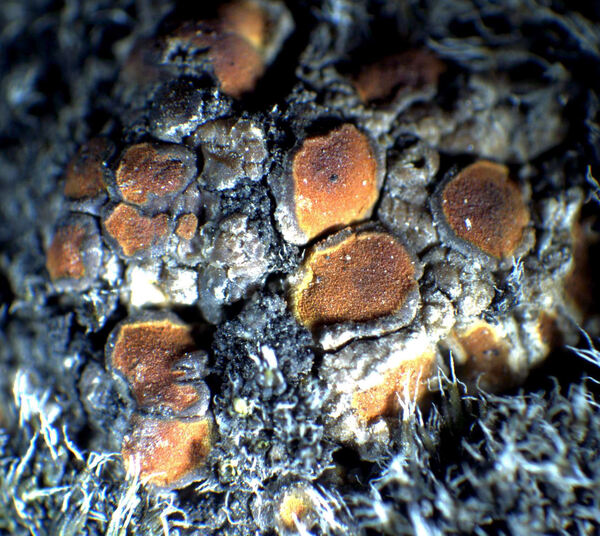Pisutiella congrediens (Nyl.) S.Y. Kondr., Lőkös & Farkas
in Kondratyuk & al., Acta Bot. Hung., 62, 1-2: 122, 2020. Basionym: Lecanora congrediens Nyl. - Flora, 66: 100, 1883.
Synonyms: Caloplaca congrediens (Nyl.) Zahlbr.; Caloplaca herminica (Samp.) Samp.
Distribution: N - Lig (Plantae Graecenses, Lichenes Nr. 255). C - Sar (Rizzi & al. 2011, Giordani & al. 2013). S - Cal (CLU 17936), Si.
Description: Thallus crustose to subsquamulose, episubstratic, pale brown to brownish-grey, often whitish-pruinose due to a thick epinecral layer, sometimes blackened in sun-forms, thick, tending to form thick pillows to 1 cm in diam. inside the cushions of mosses (esp. Andreaea- and Grimmia-species). Areoles to 0.3 mm wide, convex, contiguous and almost subsquamulose, corticate, the cortex overlain by a thick epinecral layer. Apothecia lecanorine, rounded to irregular in outline, at first immersed, then sessile, (0.3-)0.6-1(-1.5) mm across, with a cinnamon-orange to orange-brown, concave to flat disc, and a very thick, smooth, brownish to brownish grey thalline margin, sometimes also with a dark parathecial ring. Thalline exciple corticate; epithecium orange-brown, with a granular epipsamma, K+ red; hymenium colourless, 50-80 µm high; paraphyses 1.5-2 µm thick at mid-level, the apical cells only slightly swollen; hypothecium colourless. Asci 8-spored, clavate, functionally unitunicate, apically thickened with a broad internal beak, the inner part of apex and external cap I+ blue, Teloschistes-type. Ascospores 2-celled, polarilocular, hyaline, ellipsoid, 11-15 x 4-8 µm, the equatorial thickening (“septum”) 1.5-3(-5) µm. Photobiont chlorococcoid. Spot tests: thallus K-, C-, KC-, P-. Chemistry: thallus without lichen substances; epithecium with unidentified anthraquinones. Note: a montane-subtropical to mild-temperate, mainly Mediterranean-Atlantic species found on epilithic mosses overgrowing base-rich, often volcanic, siliceous rocks.
Growth form: Crustose
Substrata: rocks, soil, terricolous mosses, and plant debris
Photobiont: green algae other than Trentepohlia
Reproductive strategy: mainly sexual
Most common in areas with a humid-warm climate (e.g. most of Tyrrenian Italy)
Commonnes-rarity: (info)
Alpine belt: extremely rare
Subalpine belt: extremely rare
Oromediterranean belt: extremely rare
Montane belt: extremely rare
Submediterranean belt: absent
Padanian area: absent
Humid submediterranean belt: absent
Humid mediterranean belt: absent
Dry mediterranean belt: absent

Predictive model
Herbarium samples
Growth form: Crustose
Substrata: rocks, soil, terricolous mosses, and plant debris
Photobiont: green algae other than Trentepohlia
Reproductive strategy: mainly sexual
Most common in areas with a humid-warm climate (e.g. most of Tyrrenian Italy)
Commonnes-rarity: (info)
Alpine belt: extremely rare
Subalpine belt: extremely rare
Oromediterranean belt: extremely rare
Montane belt: extremely rare
Submediterranean belt: absent
Padanian area: absent
Humid submediterranean belt: absent
Humid mediterranean belt: absent
Dry mediterranean belt: absent

Predictive model
| Herbarium samples |
 Index Fungorum
Index Fungorum
 GBIF
GBIF



